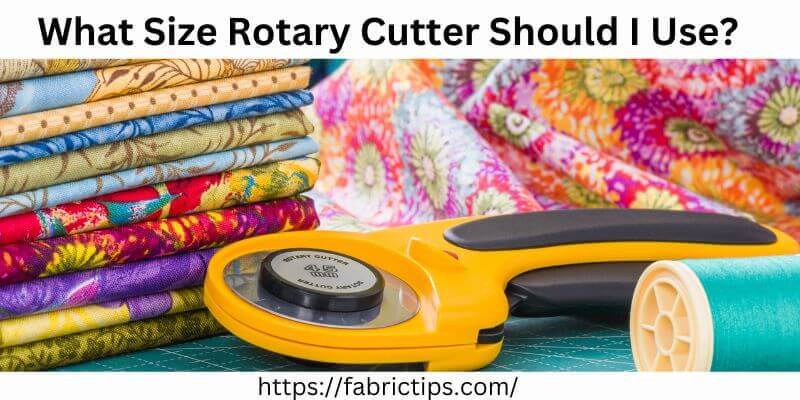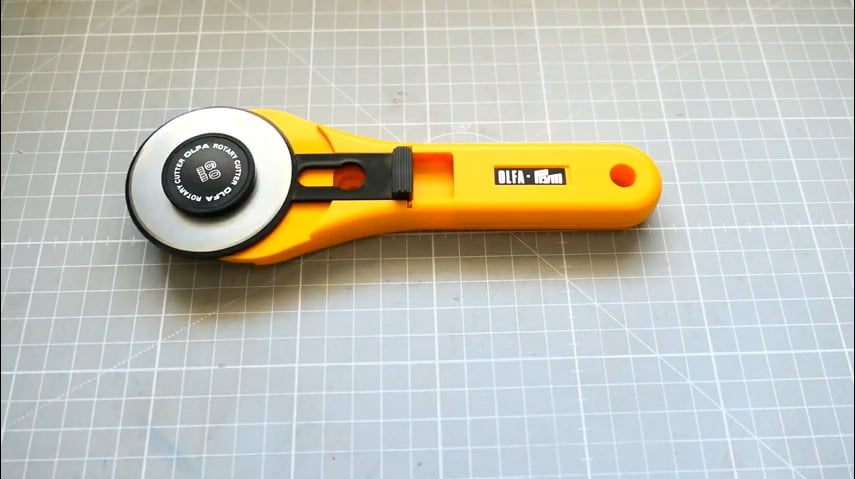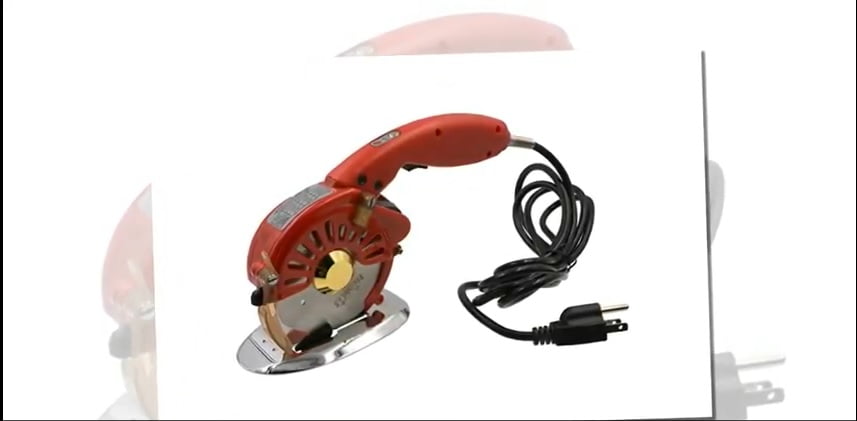Last Updated on December 19, 2023 by Wahid
If you are a new quilter, there are many tools you need to purchase for your very first project. Are you wondering what is the best rotary cutter for proper work?
Besides the sewing machine, the rotary cutter is another common tool used in sewing. Originally designed by garment manufacturers, the ruler became a popular cutting tool for quilters in the 1980s. Prior to the rotary cutter, quilters hand-cut pieces using sharp scissors. The trimming of each fabric piece and completed block demanded precision.
Fortunately, we researched and reviewed the best 5 rotary cutters for quilting that can handle simple & complex tasks. Let’s go below.
Rotary Cutters: What Are They?

Rotating razor blades are used in rotary cutters, which are paired with a handle & safety guard for protection. The blade of the cutter cuts the fabric as it runs along it. A rotary cutter is excellent for cutting strips & shapes as well as dressmaking.
However, fabric layers can easily be cut with them – just try cutting multiple layers at once to have maximum accuracy. A rotary cutter is also great for slicing slippery materials, such as velvet, silk, and knits. Since you don’t have to lift them up to cut, you can simply cut through flat to get neat edges.
What Size Rotary Cutter Should I Use?

Various sizes are available; the faster it will cut, the bigger the blade.
- An “18 millimeter” rotary cutter is ideal for small, precise cuts and curved shapes.
- Its “28mm blade” is the perfect pattern cutting blade for dressmaking, especially when cutting small curves & small cuts.
- Generally, “45mm blades” are used for general purposes.
- Ideally, a “60mm blade” should be used to cut strips of fabric and trim fabric lengths.
- A larger cutter can cut thicker fabrics & more layers at once. For quilting & home sewing, they are often used with cutting rulers and mats.
5 Best Rotary Fabric Cutters
Sewing and quilting often require cutting through fabric. Cutting fabric with scissors may work well for simple projects; however, fabric cutters are much more efficient.
Rotating fabric cutters provide smooth cutting without causing aches and pains to the wrists and hands. The rotary cutter can handle various fabric types, such as cloth, leather, foam, and others.
1. Fiskars Titanium Rotary Cutter

The Fiskars titanium rotary cutter is highly durable. With its 60mm blade, this unit can cut more thick materials effectively.
The user can cut various materials with a larger blade, including:
- Multiple layers
- Batting
- Foams
Both right-handed & left-handed users can operate this model, with the blade assembling in either direction on the unit. Whenever you view the blade, you will be able to cut even thick fabrics confidently.
Features of this model include:
- Knife blade measuring 60mm
- Enhances strength with titanium coating
- Enhanced sharpness with titanium coating
- The handle is curved for a natural grip
- An easy-to-use sliding button
- Lifetime warranty
Special Characteristics :
- When the blade of the unit is during use or in storage, Fiskars provides a sliding button that extends or retracts it.
- This blade is capable of cutting through thicker materials.
- It will be an excellent choice if you plan to use thicker fabrics for your sewing or quilting project.
- If you want a rotary cutter that is both affordable and effective, then this is the one for you.
2. Olfa 45mm Deluxe Rotary Cutter

Olfa’s 45mm rotary cutter, which is also available in 60mm, can cut through up to 6 layers at a time. Effortless and safe, Olfa offers double-action safety locks to prevent injury from accidental occurrences.
Features of this model include:
- The blade is 45mm
- Cutting 6 layers at once
- Safety lock with dual action
- Blade made from tungsten steel
- Handle is ergonomic
- Fits specialty blades
It is rare for a brand to use special blades. Olfa is one of the few. This will allow you to fit:
- The scallop or peak blades
- Wave blades
- Pinking blades
An ergonomically designed handle fits perfectly into the hand. The rubber handle makes the roller cutter easier to use and prevents fatigue. Upon pressing the trigger, self-retracting blades provide added safety.
You’ll be able to cut through a variety of materials, including:
- Felt
- Tarp
- Vinyl
- Paper
- Fleece
- Upholstery
Special Characteristics :
- Whenever you cut cotton, the roller cutter can process six layers simultaneously.
- A rotary knife from Olfa is superior to other knives, with plenty of safety features.
- Anyone who sews or quilts will benefit from this knife.
- Based on our research, Olfa’s 45mm Deluxe rotary cutter is the leading quilting rotary cutter for 2023.
3. Fiskars 45mm Contour Roller Cutter

The Fiskars roller knife is a smaller, more portable roller knife with a 45 mm blade, perfect for cutting thin materials like felt & vinyl. As a result, this tool is a great option for quickly cutting patterns out of paper.
The blade can be assembled from either side, whereas the titanium-coated blade of this model is not stainless steel. There are several features in this model:
- Blade size 45mm
- Blade made from stainless steel
- Assembly options for right- & left-handed people
- A sliding button retracts the blade and makes it safe to store
Special Characteristics :
- Due to Fiskars’ stainless-steel blade, the unit offers legendary cutting performance.
- This Fiskars blade has a 45-mm radius, making it a great choice for cutting through thin materials like foam.
- Its loop handle enhances user control while operating the rotary cutter, and its ergonomic design makes it comfortable to use.
- The design of the cutting tool makes it a practical choice for general, everyday use.
- The Fiskars rotary cutters are backed by a lifetime warranty, protecting your investment with this manufacturer.
4. Hercules 3-Speed Electric Rotary Cutting Machine

A good electric rotary cutter that can handle fabric, cloth, leather-working, & other materials. However, if you are willing to pay for it, Hercules HRK-100 is the best option. It is significantly more expensive compared to the manual alternatives we have listed. Using this model, you can easily cut through multiple layers of material.
The HRK-100 from Hercules has the following features:
- 3-speeds to choose from
- Octagonal blade of 4 inches
- Stone is built-in for sharpening
- The blade on the lower side is spring-loaded
Your sewing & quilting projects will go much more smoothly with the HRK-100 fabric cutting machine. Among its best uses are:
- Lightweight fabrics
- The medium-weight fabric
- Woven fabrics
- Knitted fabrics (loose)
Special Characteristics:
- With 3 speed options, it is possible to cut through: cloth, leather, & multiple layers of fabric.
- The machine also comes with a LED light that illuminates the cutting material while cutting.
- Despite not being industrial strength, you can use this machine to make cutting easier & more manageable.
- This will allow you to handle more material more quickly and without feeling fatigued.
- In addition, you won’t experience wrist and hand pain.
- There is only one complaint about the cord, and you’ll have to plug in an extension cord near your desk or workspace.
5. W.A. Portman Rotary Cutter

With W.A. Portman’s cutting wheel, which is 45mm thick, you can cut quilts, scrapbooks, and leather with ease.
Multiple layers of thinner fabric can be cut with this model, including:
- Felt
- Vinyl
- Paper
Safety locks with dual-actions ensure proper safety during non-use. With this design, the handle is ambidextrous, making it comfortable to hold and reducing fatigue. With 100% satisfaction guaranteed, this option offers:
- Blade diameter of 45mm
- Handle is ambidextrous
- Lock with dual action
- Assurance of 100% Satisfaction
Special Characteristics:
- In WA Portman’s opinion, the functionality of the rotary tool determines the longevity of the blades.
- This model can be equipped with replacement blades, including curved and dotted blades, to provide more cutting options.
- With this tool, you can quickly and easily remove 3 layers of light material. As a whole, it’s a great choice for a multi-purpose cutter.
- The Small, Lightweight & Compact version is a perfect option for those who need rotary cutters occasionally.
- When receiving the items, the screws on the unit require tightening. Several users said the screws had been loosened during shipping.
“Pro Tips”
- Hold the cutter in a comfortable position before you begin. It may be better to wrap all your fingers around the handle or put your index finger on top.
- Don’t bend your wrist when cutting, as this will make the cut safer and cleaner.
- Whenever you are cutting a ruler, keep your other hand securely in place.
- Don’t let your fingers hang over the edge of the ruler. Push the cutter along the ruler while applying pressure.
- Due to the circular blade and its extreme sharpness, the fabric will glide smoothly through it.
- Ensure that you press firmly when cutting into the material, but not so hard otherwise, it won’t flow smoothly. The ruler may be accidentally hit and dulled, chipping the edge.
- Whenever you finish cutting, raise the ruler instead of sliding it, then move the ruler to the next spot without moving the fabric to ensure accuracy.
- You should regularly clean your blades of dust & fabric lint.
- To ensure safety, remove the guard after you have finished cutting and slide it back over the blade.
Safety And Comfort Features
- Generally, rotary cutters come in three different designs. The blades are shielded to some degree when they are not used.
- One of the simplest designs, called stick cutters, feature a button that slides the blade into position.
- While perfectly functional, they are not usually designed ergonomically to withstand long-term use.
- Squeeze or trigger grips are featured in the second design. In many cases, the users find that it provides a more secure, knife-like grip.
- You can lower the blade by squeezing the handle. By letting go, you re-shield the blade, adding additional safety.
- In the 3rd design, the hold is similar to that of a knife, but the grip is thicker, and it has a loop (a finger grip).
- It has a slider at the back so the blade can be moved forward to cut, which may be locked in place.
- While this type of design is probably more comfortable, those with large hands may not find it comfortable.
What Is The Best Rotary Cutter: Buying Guide
Safety
- Despite your desire for the sharpest blades possible when cutting fabric, your first & foremost concern should be your safety.
- Choosing a product with a sharp blade and security features is the right choice.
- If you want to keep your fingers away from the blade and ruler, look for a rotary fabric cutter that can withdraw the blade after use.
- Another easy and effective method to prevent slippage while cutting is to use a blade guard.
Comfort
- In addition to comfort, safety is needed when using a sharp blade tool.
- In order to avoid unwanted incidents, you must feel comfortable when using it.
- Ideal cutters should have soft & shredded grips or pivots.
- If you want to avoid wrist and hand issues caused by arthritis, choose an ergonomic rotary cutter.
Size
- After safety & comfort are covered, rotary fabric cutter blade size is another important thing to consider.
- The larger the blade, the easier and smoother your work will be.
- In most cases, rotary fabric cutters have a diameter of 18mm, 28mm, 45mm, and 60mm.
- A good cutter still depends on what you prefer, so just make sure to select a blade that is both safe and comfortable.
Blade Material
- Typically, steel or titanium is the material of choice for rotary fabric cutters sold online.
- The cost of steel rotary cutter blades is lower than that of titanium blades.
- As a result of their high price, titanium blades are usually sold only at specialty shops.
- Rotary cutters with titanium blades are preferable since they tend to last a longer period of time.
FAQs
01. What can rotary cutters cut?
Fabric can be cut with a rotary cutter in a variety of ways. In addition to leather & hides, it also includes synthetic materials and rubber. Papercrafts can also be made with them.
02. What is the best size of rotary cutter for me?
It depends largely on what you’re cutting and how accurate you need to be. In general, a smaller cutter is better suited to detailed cuts & slicing through several layers of fabric. Materials with tougher surfaces & thicker layers can be cut with larger cutters.
03. Are rotary cutter blades sharpenable?
Yes, of course. There are both manual & electric sharpeners available to extend the blade’s life.
04. How do I fix my rotary cutter that won’t cut?
Blades can be damaged if they aren’t focused on a particular area. Nonetheless, eventually, all blades wear out and must be sharpened or replaced. Fortunately, quality replacement parts cannot be too expensive.
05. How do Bush Hogs and rotary cutters differ?
There are a variety of useful tools, including a “rotary cutter” or brush hog.” A brush hog is frequently called a “bush hog”, but it’s just a brand designation. “Rotary cutter” also describes the exact same tool.
06. Is a reel mower better than a rotary mower?
With a lower cut height, they provide better quality cuts compared to rotary mowers. Due to their finer turf properties, they are well suited to highly competitive and professional sports. The maintenance & operator knowledge required for reel mowers are greater than those required for rotary mowers.
07. What is the best size of rotary cutter for work?
Whenever you intend to cut a lot of fabric, you should use a 60 mm rotary cutter. In general, 18mm rotary cutters are used for cutting curves and small cuts as well. The 45mm rotary cutter is your best option for a cutter that can be used for a wide range of projects.
08. Why do you need a rotary fabric cutter?
Various types of fabrics, craft sheets, or textiles can be cut with a rotary cutter. It can cut fabric sheets into small pieces. Make a precise hole in the fabric, perforate it for crocheting or quilting, or slice vinyl to make tablecloths and car seat protectors. The versatility of rotary cutters makes them useful for many household cutting tasks.
Conclusion
With your new knowledge of what is the best rotary cutter, you can use your suited rotary cutter on fancy fabric. Therefore, it is not a problem to use the best cutter for all kinds of fabrics. With the best types of rotary cutters, multiple layers of material can be cut faster than with scissors. Times is your now to do your best cutting projects.
